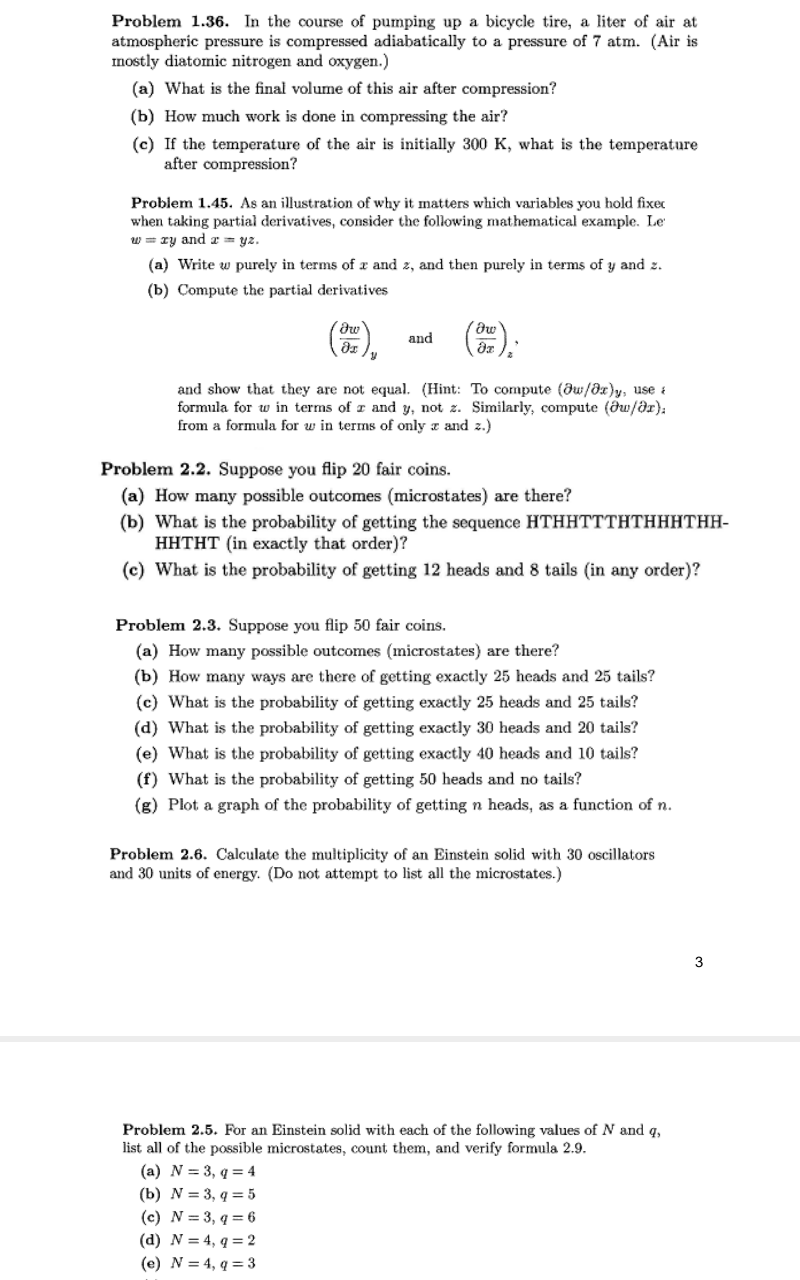Problem 1.36. In the course of pumping up a bicycle tire, a liter of air at atmospheric pressure is compressed adiabatically to a pressure of 7 atm. (Air is mostly diatomic nitrogen and oxygen.) (a) What is the final volume of this air after compression? (b) How much work is done in compressing the air? (c) If the temperature of the air is initially 300 K, what is the temperature after compression?
Problem 1.36. In the course of pumping up a bicycle tire, a liter of air at atmospheric pressure is compressed adiabatically to a pressure of 7 atm. (Air is mostly diatomic nitrogen and oxygen.) (a) What is the final volume of this air after compression? (b) How much work is done in compressing the air? (c) If the temperature of the air is initially 300 K, what is the temperature after compression?
Elements Of Electromagnetics
7th Edition
ISBN:9780190698614
Author:Sadiku, Matthew N. O.
Publisher:Sadiku, Matthew N. O.
ChapterMA: Math Assessment
Section: Chapter Questions
Problem 1.1MA
Related questions
Question

Transcribed Image Text:Problem 1.36. In the course of pumping up a bicycle tire, a liter of air at
atmospheric pressure is compressed adiabatically to a pressure of 7 atm. (Air is
mostly diatomic nitrogen and oxygen.)
(a) What is the final volume of this air after compression?
(b) How much work is done in compressing the air?
(c) If the temperature of the air is initially 300 K, what is the temperature
after compression?
Problem 1.45. As an illustration of why it matters which variables you hold fixec
when taking partial derivatives, consider the following mathematical example. Le
w = ry and æ = yz.
(a) Write w purely in terms of x and z, and then purely in terms of y and z.
(b) Compute the partial derivatives
and
and show that they are not equal. (Hint: To compute (dw/8x)y, use a
formula for w in terms of z and y, not z. Similarly, compute (ðu/az);
from a formula for w in terms of only z and z.)
Problem 2.2. Suppose you flip 20 fair coins.
(a) How many possible outcomes (microstates) are there?
(b) What is the probability of getting the sequence HTHHTTTHTHHHTHH-
HHTHT (in exactly that order)?
(c) What is the probability of getting 12 heads and 8 tails (in any order)?
Problem 2.3. Suppose you flip 50 fair coins.
(a) How many possible outcomes (microstates) are there?
(b) How many ways are there of getting exactly 25 heads and 25 tails?
(c) What is the probability of getting exactly 25 heads and 25 tails?
(d) What is the probability of getting exactly 30 heads and 20 tails?
(e) What is the probability of getting exactly 40 heads and 10 tails?
(f) What is the probability of getting 50 heads and no tails?
(g) Plot a graph of the probability of getting n heads, as a function of n.
Problem 2.6. Calculate the multiplicity of an Einstein solid with 30 oscillators
and 30 units of
(Do
attempt to list all the microstates.)
Problem 2.5. For an Einstein solid with each of the following values of N and q,
list all of the possible microstates, count them, and verify formula 2.9.
(a) N = 3, q = 4
(b) N = 3, q = 5
(c) N = 3, q = 6
(d) N = 4, q = 2
(e) N = 4, q = 3
Expert Solution
This question has been solved!
Explore an expertly crafted, step-by-step solution for a thorough understanding of key concepts.
This is a popular solution!
Trending now
This is a popular solution!
Step by step
Solved in 3 steps with 3 images

Knowledge Booster
Learn more about
Need a deep-dive on the concept behind this application? Look no further. Learn more about this topic, mechanical-engineering and related others by exploring similar questions and additional content below.Recommended textbooks for you

Elements Of Electromagnetics
Mechanical Engineering
ISBN:
9780190698614
Author:
Sadiku, Matthew N. O.
Publisher:
Oxford University Press

Mechanics of Materials (10th Edition)
Mechanical Engineering
ISBN:
9780134319650
Author:
Russell C. Hibbeler
Publisher:
PEARSON

Thermodynamics: An Engineering Approach
Mechanical Engineering
ISBN:
9781259822674
Author:
Yunus A. Cengel Dr., Michael A. Boles
Publisher:
McGraw-Hill Education

Elements Of Electromagnetics
Mechanical Engineering
ISBN:
9780190698614
Author:
Sadiku, Matthew N. O.
Publisher:
Oxford University Press

Mechanics of Materials (10th Edition)
Mechanical Engineering
ISBN:
9780134319650
Author:
Russell C. Hibbeler
Publisher:
PEARSON

Thermodynamics: An Engineering Approach
Mechanical Engineering
ISBN:
9781259822674
Author:
Yunus A. Cengel Dr., Michael A. Boles
Publisher:
McGraw-Hill Education

Control Systems Engineering
Mechanical Engineering
ISBN:
9781118170519
Author:
Norman S. Nise
Publisher:
WILEY

Mechanics of Materials (MindTap Course List)
Mechanical Engineering
ISBN:
9781337093347
Author:
Barry J. Goodno, James M. Gere
Publisher:
Cengage Learning

Engineering Mechanics: Statics
Mechanical Engineering
ISBN:
9781118807330
Author:
James L. Meriam, L. G. Kraige, J. N. Bolton
Publisher:
WILEY